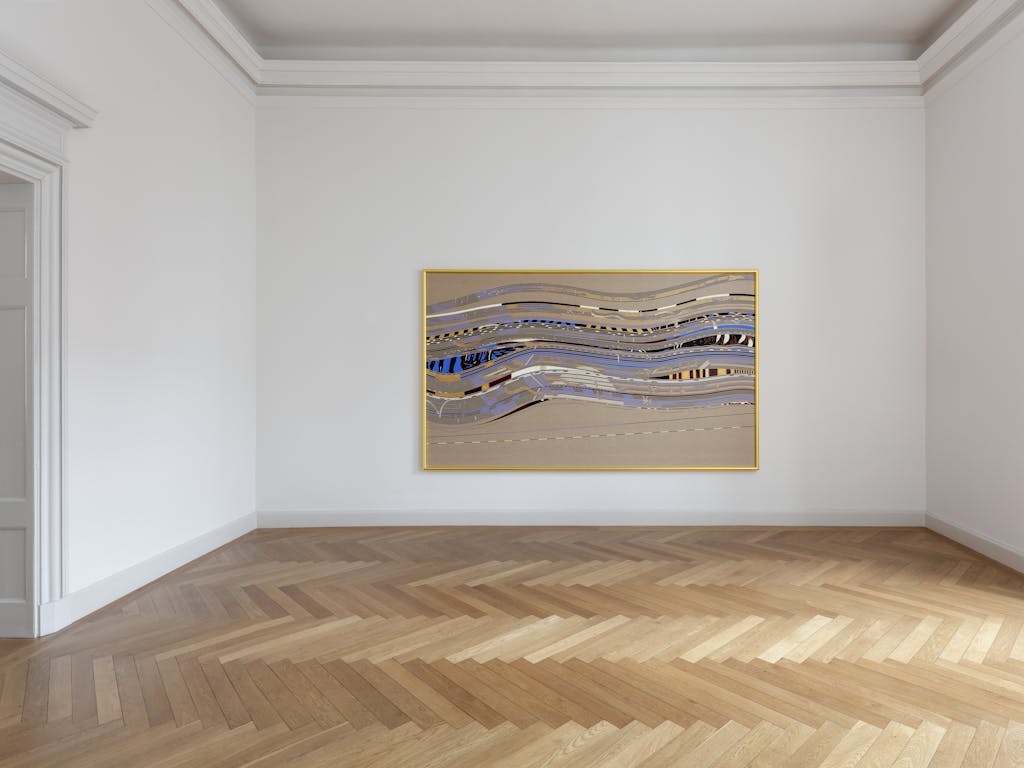The exhibition takes its title from a group of three works, each made in the same lustrous, heavy colour spectrum of black, gold, coagulated blood red and a dark shade of sky blue. “White Black Death Gold“ (2019) is the largest painting of this group. On this wide landscape format Frieberg combines two of her most important formal languages: a very graphic layer of accurately taped lines extends in a wavelike movement across thick and expressive brushstrokes. In this interplay of positive and negative forms, Frieberg pays exact attention to every detail. The monochrome or patterned lines juxtapose different rhythms and scales that create movement.
In Frieberg’s works, each colour has its own reference, and is often charged with symbolic meaning. Further to the sensual quality they contribute to the paintings, Frieberg’s colours are conceptually linked to locations and their atmospheres — whether they are a product of her imagination or she has visited them in nature. During a long-term creative process Frieberg starts with plein-air sessions in which she extracts the colours of her surroundings and captures them in colour schedules on paper. Back in her studio these samples serve as fund which she bases her paintings on.
“White Black Death Gold (Center Beam)“ (2019) is a strictly geometric arrangement of these colours, creating a draw to the very center of the square canvas. The colour beams in one half of the painting are darkened, based on Frieberg’s experience of the particular black colour of shadows in Canadian landscapes. It disproved the widely spread theory of painting that no black ever appears in nature and tempted Frieberg to experiment with black in this colour spectrum, creating an even more dramatic effect.
Due to an injury caused by a bike accident this past summer, the artist started painting with her left hand: “White Black Death Gold (Left hand)“ (2019) contrasts more than any other painting Frieberg’s technically impeccable line drawings with liberated, almost insecure brushstrokes, thus creating extraordinary tension between these layers. Frieberg relates to her works in a very physical way. With this painting’s size matching her body scale, she is able to immediately bring the movements of her body onto the canvas.
“Panorama, Tuscany“ (2019) is a personal geography derived from Frieberg’s experiences outside of Florence. It mirrors her impressions of the Italian landscape and its atmosphere, highlighted with references of specific memories like splashing water of a dog playing in a pool, or architectural elements like a golden mosaic grid in one of the city’s greatest landmarks, the 12th century Baptistery of Saint John.
Frieberg’s awareness of the history of painting is apparent in the importance she attributes to her frames: strikingly gilded in copper or gold, they remind of medieval or renaissance paintings she studies carefully during her visits to picture galleries, especially the one decorated in black and gold which encloses the vivid brushstrokes of “Green, Gold, Torso, Tuscany“ (2019). The strictly painted bars on the frame not only contrast strongly with the movement on the picture plane of Frieberg’s abstract self portrait. At the same time they resonate with the proportions and colour scheme of the painting, thus extending the canvas.
In “Dive, Heaven, Water, Hell, No. 2“ (2019) Frieberg even takes up a particular historic painting. It is the artist’s continuation of “The Temptation of Christ on the Mountain“ (1308-11), one of the panels of Duccio di Buoninsegna’s medieval Maestà altarpiece that shows Christ rejecting the Devil. In Frieberg’s interpretation, expressed by powerful brush strokes and a dynamic composition in a high format, the Devil — like a steep diving bird — bursts back into hell from heaven, both marked on the diagonally divided canvas through different colour schemes.
Elisabeth Frieberg (b. 1977, Sweden) lives and works in Stockholm. Her work has been exhibited at Magasin III Museum & Foundation for Contemporary Art, Stockholm (2017); Index – The Swedish Contemporary Art Foundation, Stockholm (2016); Uppsala Konstmuseum, Uppsala (2015); and Fondazione Cini, Venice (2015), amongst other institutions. Her works are included in public collections such as the Moderna Museet, Stockholm; Magasin III Museum & Foundation for Contemporary Art, Stockholm; The National Public Art Council Sweden, and the Aguélimuseet, Sala.
